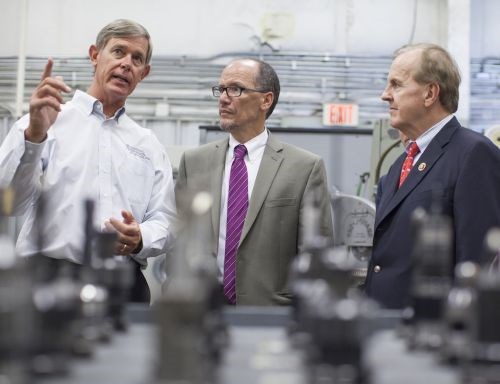Feds Intrigued by North Carolina Apprenticeship Programs
Seeking workforce development models that could be replicated on a national level, the U.S. Labor Secretary and other officials have visited two mold manufacturers in the Tar Heel state this year alone.

Secretary Perez (center) visited Ameritech with U.S. Reps Robert Pittenger (R) and Virginia Foxx (R), both visible to the right. As implied by the message on the back of this apprentice's shirt, many of the company's newer hires could have a virtually debt-free pathway to the middle class. (Image courtesy of US Department of Labor, Public Affairs.)
“If we had more Ameritechs, we’d have even more success as a country.”
Courtesy of a recent article in the Statesville Record & Landmark, that quote came direct from U.S. Labor Secretary Thomas Perez during a recent visit to Mooresville, North Carolina-based plastic injection mold manufacturer Ameritech Die & Mold. Along with U.S. Reps. Robert Pittenger (R) and Virginia Foxx (R), the secretary toured the shop June 30 to learn more about its efforts with Apprenticeship 2000, a workforce development program that Ameritech joined as a founding member nearly two decades ago.
Although this program has been covered extensively in various media outlets (MMT did a Q&A with Ameritech president Steve Rotman just last year), I was excited to hear that it’s getting attention from the highest levels of government. Rotman, for his part, was even more excited to tell me about it. Beyond positive exposure for his own shop, the visit validates Ameritech's approach to workforce development--an approach based on a model that’s helped ensure a bountiful pool of skilled labor in countries like Switzerland and Germany since the Middle Ages. Just as importantly, it provides further indication that more than just industry types recognize the skilled worker shortage as a potentially crippling barrier to our competitiveness.

Steve Rotman, Ameritech president (far left), confers with Secretary Perez and U.S. Rep. Robert Pittenger. (Image courtesy of US Department of Labor, Public Affairs.)
Indeed, this past December, President Barack Obama and the Department of Labor announced $100 million in funding to expand apprenticeships for American workers. Meanwhile, Secretary Perez has been touring various companies in search of workforce development program models that could be replicated on a national level. The aforementioned article provides a more in-depth look at his tour of Ameritech, but that’s not the only North Carolina mold manufacturer he’s met with in recent months. Back in February, he met with members of the North Carolina Triangle Apprenticeship Program (NCTAP), including Robbie Earnhardt, president of Wake Forest-based Superior Tooling. Notably, NCTAP is based on the same basic model as Apprenticeship 2000, which members credit with helping to get the newer organization off the ground.
All of this is driving plenty of media attention, too, and that includes more than just this publication and the local newspaper mentioned above. Last week, the New York Times published a terrific overview of recent efforts in workforce development, and that article includes a direct shout-out to Ameritech. It's well worth a read.
Related Content
-
Eden Tool and Eden Manufacturing: A Story of Resilience, Growth and Innovation
This critical parts manufacturer, founded on solid tooling fundamentals, didn’t get derailed with the unexpected passing of the owner because leadership was already building a solid business, not just a good tool shop. Here’s how they managed change incrementally… and they’re not finished yet.
-
Confronting the Mold Design Talent Drought
Recently, I reposted on LinkedIn the results of an informal survey we conducted, which revealed a shortage of skilled mold designers. It quickly gained a lot of traction. Given the response, I thought I'd summarize the feedback and keep the conversation going.
-
MMT Chats: The Connection Between Additive Manufacturing Education and ROI
This MMT Chat continues the conversation with Action Mold and Machining, as two members of the Additive Manufacturing team dig a little deeper into AM education, AM’s return on investment and the facility and equipment requirements to implement AM properly.
















